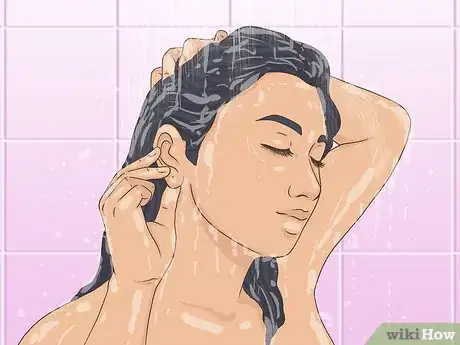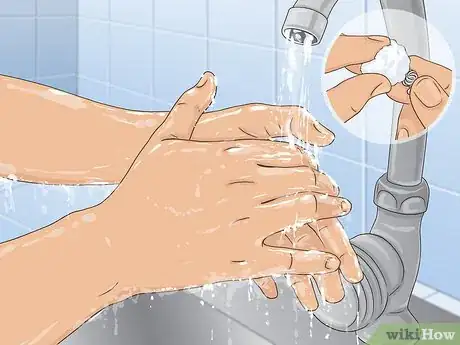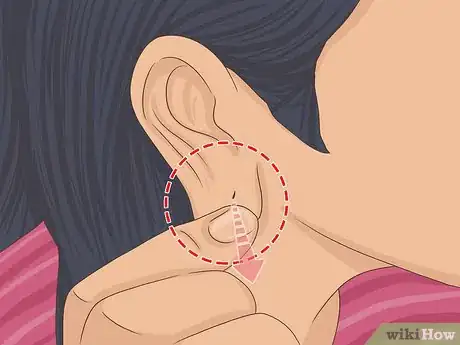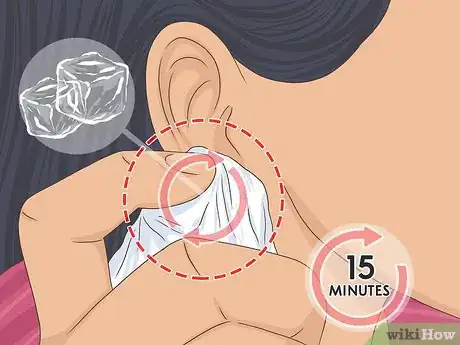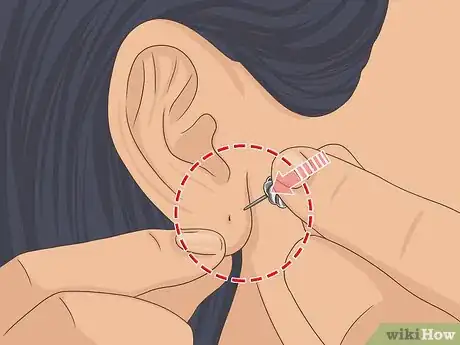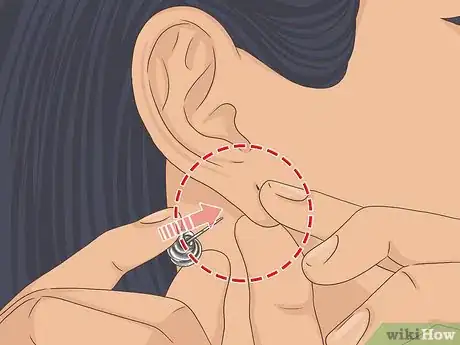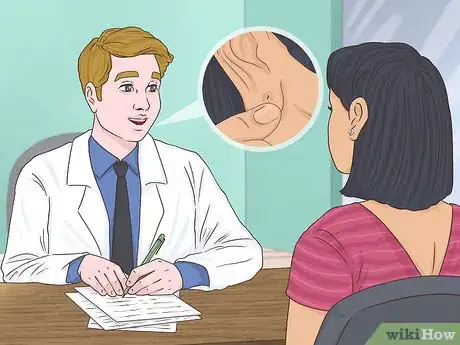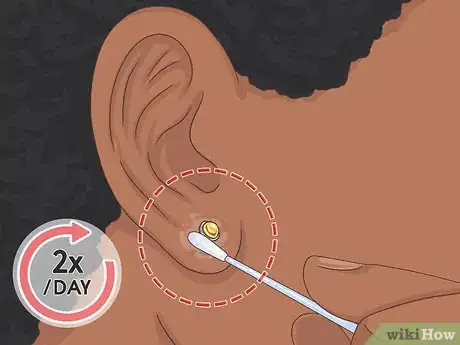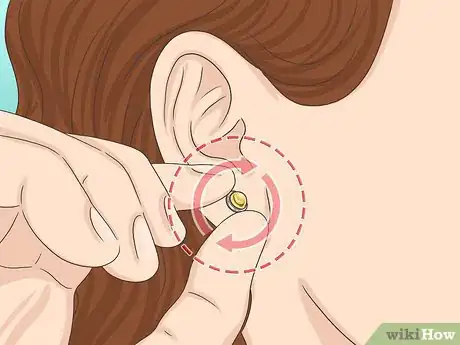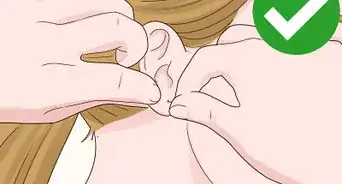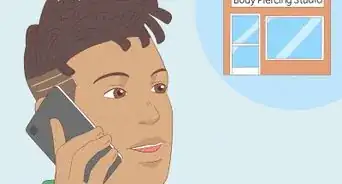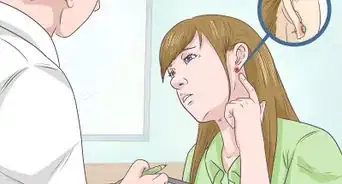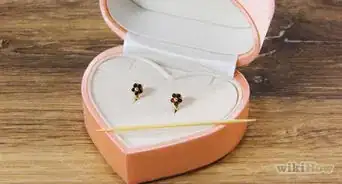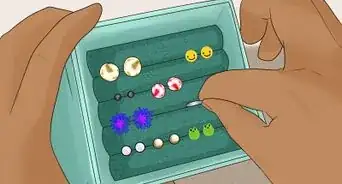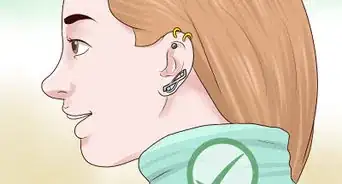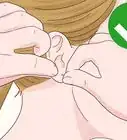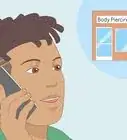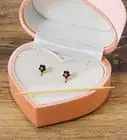This article was co-authored by Stephanie Anders. Stephanie Anders is the Owner and Head Piercer at Royal Heritage Tattoo and Piercing, a tattoo and piercing studio located in Los Angeles, California. Stephanie has over 10 years of piercing experience and her client list includes such stars as Jennifer Aniston, Jessica Alba, Cameron Diaz, Nicole Richie, Gwyneth Paltrow, and Sharon Osbourne.
There are 7 references cited in this article, which can be found at the bottom of the page.
This article has been viewed 417,793 times.
Maybe you recently pierced your ears, taken the earrings out, and can't seem to get them back in. Well, don't panic! The hole may not have completely closed, and if you follow some simple steps, you can get that earring in with little to no pain.
Steps
Re-inserting an Earring in a Standard Lobe Piercing
-
1Take a shower or bath to soften the skin of your earlobe. Before attempting to insert an earring when the hole is almost completely closed, you’ll want to make sure your skin is soft. This will help to make the piercing go in easier, and reduce any pain you might experience. Try to insert the earring after taking a bath, shower, or even after a swim.[1]
-
2Wash your hands and sterilize the earring posts. Before inserting the earrings, you’ll want to make sure your hands and the earrings are clean to avoid infection and irritation. Wash your hands thoroughly with soap and water then grab some rubbing alcohol or hydrogen peroxide. Both are great disinfectants. Dip a cotton ball or pad into your chosen cleaning solution and then gently rub it on your earrings.[2]
- You can also put your earrings in a small bowl of hydrogen peroxide and let them soak for 10-20 minutes.
- Put your cleaned earrings on a paper towel to dry before attempting to put them in your ear.
Advertisement -
3Stretch the earlobe to widen the hole. If the hole isn’t completely closed off, you can stretch your earlobe to increase the size and reduce thickness of the hole. To do this, gently tug on the area around the piercing with your thumb and index finger. This should allow your piercing to go right in with little to no pain.[3]
- Check the front and back of the lobe to see if the hole has widened before inserting the earring. You can use a small, handheld mirror to see the back of the lobe.
-
4Apply ice to the earlobe to numb it before inserting the piercing. If you do not see the hole opening, or are worried about pain when you put your earring in, you can numb it with ice. Grab 1 or 2 ice cubes and wrap them in a paper towel. Place them on the front of your earlobe and rub in a circular motion for 15 minutes. Do this on the back side of the ear lobe as well, until the area feels cold and numb.[4]
- You can also use some numbing cream if you prefer.
-
5Push the post through the front of the earlobe with gentle pressure. Now it’s time to get that earring back in the hole. A thin tissue membrane may have formed around the hole, so you’ll need to apply some pressure to get the earring in. [5]
- Using a mirror, look behind the ear to see the earring post pushing against the lobe. This is a way for you to find the thinnest part of the lobe so that you can easily push the earring through.
-
6Insert the earring from the back of the lobe if it doesn’t work from the front. You may have trouble getting the earring through the hole from the front. If this is the case, slightly turn your ear lobe and try to insert the earring from the back. The hole may be more open from that side.[6]
-
7Experiment with different angles if the earring won’t go through immediately. If you tried to put the earring in from the front and back of the lobe and it still won’t go in, try to insert it from different angles. It might go in if inserted at the right angle.[7]
- Cartilage piercings close quicker than standard ear lobe piercings. Be very careful when attempting to re-insert these piercings, it may hurt! If the earring won’t go in with some pressure, the hole might have already completely closed, and you need to see a professional.
-
8Contact a professional if the earring won’t go back in. If you experience a significant amount of pain when applying gentle pressure, or if the earring post starts to bend, stop attempting the insertion. Your earring hole has completely closed, and you’ll need to get it re-pierced.[8]
Caring for the Piercing after Insertion
-
1Keep your earrings in for 6-8 weeks to keep the hole open. Once you have re-inserted your earring, you want to make sure the hole doesn’t close back up. Keep the earring in at all times (even at night) for at least 6 weeks to make sure this doesn’t happen again.[9]
- Once the 6-8 weeks have passed, try not to go more than 1 or 2 days without earrings. The holes can quickly close up again. You’ll want to keep earrings in your ears daily for up to a year for the piercing to stay for a significant amount of time.
-
2Clean the piercing twice a day to avoid infection. To clean your piercing, use mild soap, saline solution, or warm salt water. Dip a cotton swab into your preferred cleaning solution. Then apply the swab around the piercing to clean it. Do this on the back of the ear as well.[10]
- Clean your piercing twice daily for up to 6 weeks while it is healing.
- Avoid harsh soaps and anti-bacterial products when cleaning your piercing.
-
3Twist the earring after cleaning to keep the pierced holes open. Every time you wash your piercing, which should be at least twice a day, gently twist the earring around in the hole while it’s wet. Twist it clockwise, counterclockwise, then slightly back and forth. This will prevent your skin from sticking to the earring.[11]
- Only twist the earring after you have washed it and while it’s still wet. If you twist it too much while it’s dry, you may irritate the piercing and delay healing.
Expert Q&A
-
QuestionIs it normal for an ear piercing to have a bump?
 Stephanie AndersStephanie Anders is the Owner and Head Piercer at Royal Heritage Tattoo and Piercing, a tattoo and piercing studio located in Los Angeles, California. Stephanie has over 10 years of piercing experience and her client list includes such stars as Jennifer Aniston, Jessica Alba, Cameron Diaz, Nicole Richie, Gwyneth Paltrow, and Sharon Osbourne.
Stephanie AndersStephanie Anders is the Owner and Head Piercer at Royal Heritage Tattoo and Piercing, a tattoo and piercing studio located in Los Angeles, California. Stephanie has over 10 years of piercing experience and her client list includes such stars as Jennifer Aniston, Jessica Alba, Cameron Diaz, Nicole Richie, Gwyneth Paltrow, and Sharon Osbourne.
Owner, Royal Heritage Tattoo and Piercing It can be! For example, if you have a cartilage piercing and you've slept on that piercing that night, it's normal to wake up with a bump. If the bump goes away during the day, without the irritating factor of sleeping on it any longer. If you have more persistent bumps that don't go away on their own, you should probably dig into it a little bit or even talk with your piercer or with a doctor.
It can be! For example, if you have a cartilage piercing and you've slept on that piercing that night, it's normal to wake up with a bump. If the bump goes away during the day, without the irritating factor of sleeping on it any longer. If you have more persistent bumps that don't go away on their own, you should probably dig into it a little bit or even talk with your piercer or with a doctor. -
QuestionWhat if I can get if through the right ear, but can't get it through the left ear?
 Community AnswerTry putting it in with your other hand. Sometimes it's just the angle you're coming from.
Community AnswerTry putting it in with your other hand. Sometimes it's just the angle you're coming from. -
QuestionWhat if the piercing is there but you just can't get it in?
 Community AnswerFirst of all, don't panic. You may have grown some ear skin or a scab where your piercing is. Gather isopropyl alcohol and tissue or cotton swabs/balls to soak up any bleeding or pus. Also, make sure you have some ice, and a thin-needled earring. Ice the area until it is numb. Then wiggle the earring in the back of the ear to find where you will poke the earring through. Go to the front, and try to slide the earring in. If this doesn't work, and the earring gets stuck, take the earring out and ice your ear again to total numbness. Then, gently, carefully, and delicately, poke the earring through the skin or scab. Apply ice afterwards.
Community AnswerFirst of all, don't panic. You may have grown some ear skin or a scab where your piercing is. Gather isopropyl alcohol and tissue or cotton swabs/balls to soak up any bleeding or pus. Also, make sure you have some ice, and a thin-needled earring. Ice the area until it is numb. Then wiggle the earring in the back of the ear to find where you will poke the earring through. Go to the front, and try to slide the earring in. If this doesn't work, and the earring gets stuck, take the earring out and ice your ear again to total numbness. Then, gently, carefully, and delicately, poke the earring through the skin or scab. Apply ice afterwards.
Warnings
- If you notice any yellow-ish liquid coming from the piercing, it may be a sign of an infection. See a doctor or dermatologist immediately.⧼thumbs_response⧽
References
- ↑ https://goaskalice.columbia.edu/answered-questions/it-possible-reopen-closed-piercing
- ↑ https://www.entitymag.com/how-to-clean-earrings-like-a-pro/
- ↑ https://goaskalice.columbia.edu/answered-questions/it-possible-reopen-closed-piercing
- ↑ http://www.cnn.com/2010/HEALTH/expert.q.a/08/30/earring.holes.closing.shu/index.html
- ↑ http://www.cnn.com/2010/HEALTH/expert.q.a/08/30/earring.holes.closing.shu/index.html
- ↑ http://www.cnn.com/2010/HEALTH/expert.q.a/08/30/earring.holes.closing.shu/index.html
- ↑ http://www.cnn.com/2010/HEALTH/expert.q.a/08/30/earring.holes.closing.shu/index.html
- ↑ https://goaskalice.columbia.edu/answered-questions/it-possible-reopen-closed-piercing
- ↑ https://www.aad.org/public/skin-hair-nails/skin-care/caring-for-pierced-ears
